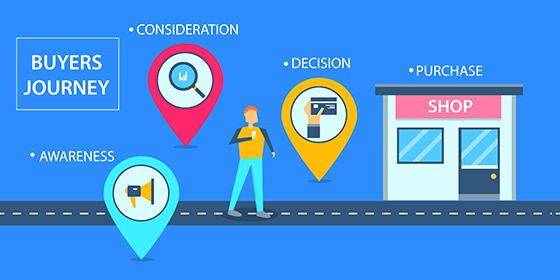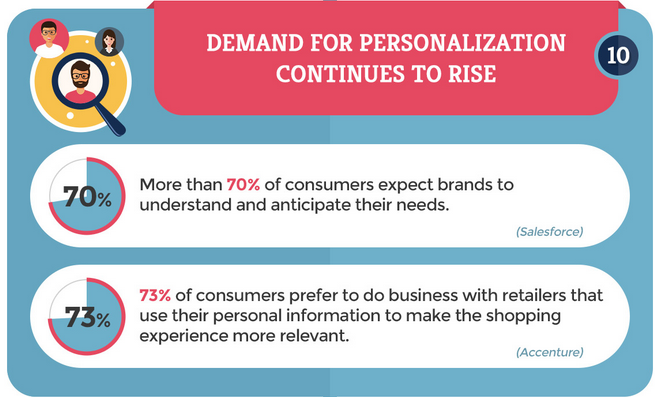5 Technologies to Improve the Customer Experience Journey
Consumers today have a high expectation when it comes to how they want to engage and shop  with a brand. With all the intelligence that is circling around customer experience, customers expect to be known by the brands they shop with and expect their interactions to be personal, meaningful, and most of all, easy. These changes in expectations by consumers are driving huge transformations in the industry.
with a brand. With all the intelligence that is circling around customer experience, customers expect to be known by the brands they shop with and expect their interactions to be personal, meaningful, and most of all, easy. These changes in expectations by consumers are driving huge transformations in the industry.
Retailers today know that it’s imperative to meet their customers across all channels with tailored interactions, making the customer feel like every shopping experience has been designed with their unique preferences in mind. As new technologies arise, from chatbots to product recommendations and smart fitting rooms, merchants have focused personalization efforts on the browsing and transacting experience.
So let's take a moment to review some of the technologies, businesses need to engage in to help boost and improve the customer experience journey across the board.
1. Automation / Chatbots
Automation is all about putting certain tasks on autopilot while you and your employees focus their talent and energy elsewhere. IT research firm Gartner has predicted that by 2025, 95% of customers will experience customer service without having speaking to a human being. This means that the apps and automated response systems that are currently dealing with these requests will soon be replaced by more advanced AI within the upcoming years.
A chatbot allows customers to get solutions for their problem quickly, building trust with your brand and satisfying the need for instant gratification. More than that, chatbots act in place of customer service teams for basic questions that can bog down phone lines and emails. By automating the simple, your customer service team can help customers with the complex – faster. And can reduce hold time.
Setting up an effective chatbots could be the answer. When I say effective, I mean programmed to the highest level of intelligence. With the advancement in machine learning, chatbots are able to understand and empathize, which allows them to reach their full potential.
2. Big Data Analytics / Machine Learning
To improve the customer experience you need to collect and analyze data, which is a big undertaking. With massive amounts of data received by a business through various activities, it becomes increasingly important for them to analyze this data and use it for delivering a better experience to end consumers.
With the help of big data analytics, growing businesses can conveniently gather useful insights into consumer preferences and behaviours that help them provide personalized services. The nature of personalization helps a business build a loyal customer base and improve revenues over the long term.
Big data analytics is transforming the way businesses interact with customers. The technology helps a brand/business understand customers’ problems, aspirations, and expectations, which help in quicker resolution and providing tailor-made solutions according to personal expectations. If you could take a negative experience and move it into a good experience in a few minutes, would you do it? Of course, you would.
Machines can take all the data leading up to a positive experience and learn the difference between positive and negative. If a customer is well on their way towards a negative experience, that data is collected, leading artificial intelligence to decide which the best next step to improve it is.
3. Artificial Intelligence
Artificial intelligence has taken the business landscape by storm, owing to the enormous potential benefits it projects for business growth. With the help of artificial intelligence-powered tools, businesses can pump up the business process automation and can strike up conversations that are relevant to the individual customers. Empowering customer support conversations and improving decision-making abilities within organizations through automation. AI helps humans to provide proactive and actionable responses to customers quickly, improving customer satisfaction, eventually.
There is a reason why customers purchase certain products. Finding out the “why”, artificial intelligence can give us enough insight into a buyer’s journey to answer that impossible question: “why they selected this and not that”?
During the buyer’s journey, they may decide that another product is better suited to their needs. The goal here is to use AI to decide where that decision is made and why it was made. Was it a negative website experience? Was it the cost of the product? Was it another ad that caught their eye?
The more AI can learn about your customers, the better your marketing team can create messages for each stage of the customer lifecycle, thus improving customer satisfaction. Imagine a marketing campaign that fit every stage of the customer’s purchase like a glove, saying all the things that customer wants to hear. This type of customer satisfaction is only achievable with AI.
4. Virtual Reality
Virtual reality is a breakthrough technology that is transforming the consumer experience landscape for modern businesses. Virtual reality has the potential to completely alter the consumer experience as we know it.
VR can engage customers in a better way, as the technology is designed to provide a complete sensory experience that captures the attention, imagination, and senses unlike any other technology present in modern times.
Offering an immersive experience such as the virtual change room, VR is helping businesses to engage consumers in a better way than other technologies, motivating consumers to interact in a better way with a product/brand, delighting them.
5. Internet of Things (IoT)
As Internet of Things (IoT) devices infiltrate people's homes and offices, consumers increasingly look for IoT experiences that are monitored, personalized, improved, and updated with new features, according to a Forrester report. As IoT solutions help businesses lower operational costs, and increase productivity and expansion, businesses are actively adopting such solutions to engage customers with delightful experiences. The report also mentioned that businesses can capitalize on data collected by IoT devices to deliver personalized experiences to customers in the physical world.
IoT solutions enable a business to effectively deploy promotional campaigns across different platform through a relationship between digital and real world activities, these have a great potential to attract consumers towards a business service or product.
Getting to know all about your customers is important to be able to design products and create campaigns that convert. The IoT can collect so much crucial information and can give insight into what that ideal customer looks like, down to their average age, how they use the internet to search for products and even the type of experience they wish to have.
Ending Notes
We are in the age of commerce and we must look past the front end experience and also bring the same personalization innovation to the back end. The strategic use of new technologies like big data and artificial intelligence (AI) across supply chains, fulfillment centers, manufacturing and more is the key to unlocking a new degree of personalized customer experience. By infusing personalization technologies from the inside out, not simply tacking it on the front end, retailers can unlock a new realm of customer experiences.

In this competitive business age, customers have several alternatives and customer retention is a major challenge. Leveraging the advantages of technological advancements, a business can easily satisfy and retain its customer base and improve the efficiency of the business. This year is expected to bring so many new advancements in customer satisfaction. The only way for your business to stay competitive is to take advantage of the technology that is at your fingertips.
Isn't it time to let technology do the customer experience for you?

Natalie Evans
Natalie Evans has over 16-years in the tech industry and currently works as the event coordinator and tech reporter for CMS-Connected, keeping up-to-date on what's happening in and around the Content Management industry.